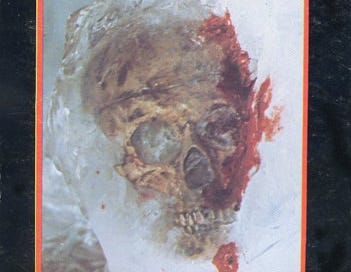The late 1970s had a sword & sorcery fiction boom. Zebra Books rising out of the ashes of Lancer Books published mass market paperbacks of Robert E. Howard non-Conan fiction starting in 1975. That in turn spurred publishers for a new crop of sword & sorcery fiction.
An entry from the near the end of the 70s sword & sorcery boom was C. E. Owston's The Scarlet Skull. This is the only entry of fiction from the author. Manor Books published the book in July 1979. You heard The Knack's “My Sharona” all over the radio. Disco ruled the airwaves but was about to die a very quick death. Barbarians seemed to be all over paperback book covers when you went to B. Dalton Bookseller or Waldenbooks.
The Scarlet Skull is set in an antediluvian world before the sinking of Atlantis. The very long lived sorceror Norkias of Atlantis has decided to conquer the world. He has seized control of Atlantis and ready to make a move on the continent to the west.
There is a scene of alliance with the barbaric Aetherians. There is a type of hybrid type of overwriting that combines Clark Ashton Smith and Robert E. Howard that you often see in some sword & sorcery.
“The aura of nameless horror still clung to the place, tainting the glittering wet monoliths with its malign influence. . .It pulsed and writhed like a spectral glint of weird hellfire, ever growing before their eyes.”
The word lambent always seems to show up with this sort of prose.
Norkias gets his barbarian army to attack the premier nation of Thaumasia. The geography does not always make sense as you have fens and woods of Aetheria against the desert of the Forbidden Lands (which has cities).
Then you have the temperate land of Thaumasia beyond the the desert Forbidden Lands. Attention switches to Vika the Zepherian who serves as a commander of a contingent of Thaumasia. There is a battle where sorcerous fire bolts from Norkias cut down much of the Thaumasian Army. Vika escapes the disaster and begins the quest on stopping Norkias. Norkias needs Vika's skull to complete a plague spell.
There are some more battles, the addition of allies, the rescue of the heir apparent of Atlantis. The prose eases up from the H. P. Robert E. Clark Ashton Howard prose. Owston actually moves the story right along in 244 pages.
There is the Robert E. Howard and Clark Ashton Smith influence. Also Michael Moorcock with the big freaky deaky sorcery. Moorcock's influence was looming large with a wave of writers who emerged in the 1970s.
The novel is derivative but a fun romp if you are not looking for anything profound. This is not an easy novel to find. It took me a few years in the mid-90s when I heard about it. Then I heard from C. E. Owston's brother. I think I posted something on AOL back in the late 90s or I had mentioned it in article for one of Dennis McHaney's publications. I got in touch with Owston. Chuck Owston is from western Pennsylvania, plays at medieval fairs, and in the Rockabilly Hall of Fame. He told me that he wrote a sequel that was never published.
He told me that Manor Books almost paid him nothing. None other than Karl Edward Wagner went to bat for him and got Manor Books to fork some money over.
So, if you run across The Scarlet Skull in a used bookstore, snatch it up. It is rare. Manor Books probably had variable distribution. The cover did not help with sales. Manor would cease after 1980. For some reason you can find Mike Sirota books by Manor easily in used bookstores. Just brace yourself for typos as Manor never did a good job with proofing. This was an end of an epoch. Publishing changed. C. E. Owston showed promise in the first novel. It would have been interesting to see him mature as a writer had more novels been published.






I never found this one even though that was the time I spent a couple days a week at the library (the bookmobile had quit running about then). Thanks for finding these little time capsules about the genre books. I wonder what the ruins of Amazon will leave future generations.